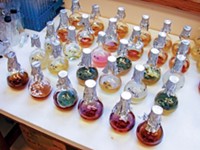Advertisement
Grab your lab coat. Let's get started
Welcome!
Welcome!
Create an account below to get 6 C&EN articles per month, receive newsletters and more - all free.
It seems this is your first time logging in online. Please enter the following information to continue.
As an ACS member you automatically get access to this site. All we need is few more details to create your reading experience.
Not you? Sign in with a different account.
Not you? Sign in with a different account.
ERROR 1
ERROR 1
ERROR 2
ERROR 2
ERROR 2
ERROR 2
ERROR 2
Password and Confirm password must match.
If you have an ACS member number, please enter it here so we can link this account to your membership. (optional)
ERROR 2
ACS values your privacy. By submitting your information, you are gaining access to C&EN and subscribing to our weekly newsletter. We use the information you provide to make your reading experience better, and we will never sell your data to third party members.
Letters to the editor
Mining for microbes
We very much enjoyed the article on the exciting prospects of mining for microbes with the capability of making useful metabolites (C&EN, May 6, page 34). Microbes have been utilized for the production of novel bioactive compounds, as well as for the remediation of hazardous waste sites, the production of biofuels, and the promotion of human health. The discovery of antibiotic-producing microorganisms from a wide range of habitats is a prime example.
Unfortunately, the article has an error about the discovery of streptomycin from a soil fungus on Easter Island. Although microbes that produce streptomycin could likely be isolated from Easter Island soils, the discovery of streptomycin was first reported in 1944 by Albert Schatz, Elizabeth Bugie, and Selman Waksman at the New Jersey Agricultural Experiment Station at Rutgers University in New Brunswick, New Jersey (Proc. Soc. Exp. Biol. Med. 1944, DOI: 10.3181/00379727-55-14461). The antibiotic is produced by the bacterium Streptomyces griseus, which was isolated twice: once from a chicken gullet and once from a soil, both samples from New Jersey.
In the early 1940s, Waksman and his group developed the systematic screening methods used to isolate microbes that produce bioactive compounds, culminating in the discovery of streptomycin, the first effective broad-spectrum antibiotic providing a cure for tuberculosis. This is a paramount example of the “microbial mining” discussed in the C&EN article. Waksman received the Nobel Prize in Physiology or Medicine in 1952 for the soil microbe studies that led to the discovery of streptomycin. Waksman’s work is designated as a National Historic Chemical Landmark by the American Chemical Society. Waksman embraced the study of soil microbes, in particular the filamentous actinomycetes that include the Streptomyces. The Streptomyces give soil that wonderful earthy aroma (geosmin), metabolize organic materials to maintain soil fertility, and are a major source of several other antibiotics and bioactive compounds. The actinomycete bacterium Streptomyces griseus, discovered in New Jersey, has dramatically advanced world health and was formally recognized as New Jersey’s state microbe on May 10. Previously, Oregon designated Saccharomyces cerevisiae, brewer’s or baker’s yeast, as its state microbe in recognition of its importance to the state’s brewing industry. Illinois is considering naming Penicillium chrysogenum, which is a source of penicillin, as its state microbe. The formal designation of state microbes shines a light on the power of microbes and microbiology. It highlights the treasure trove of microbial activities and metabolites that can be utilized to address relevant societal hurdles.
Max Häggblom, Douglas Eveleigh, Jeff Boyd (New Brunswick, New Jersey), and John Warhol (Leonardo, New Jersey)
Editor’s note: The C&EN article on mining microbes was updated on May 8 to correct the description of streptomycin’s origin.
Career stories
I am writing to you in regard to your column Career Ladder. You profile some fabulous chemists, among them Dana Garves (the beer lady! Though I don’t drink beer, I thought her story was pretty fantastic), Rebecca Robbins (the sweets lady!), and Andrew Davis and his position in the preservation department at the Library of Congress (we were in Washington, DC, in the fall and were amazed at the great reading room there).
The recent article about Vy Dong was very well written, and I enjoyed reading about her career path, since my husband and she had the mentorship of Larry Overman in common (at different times, though). However, I really wonder how representative it is for the majority of chemists. I am a lecturer at the University of Tennessee at Chattanooga, where many students are first-generation college goers. The majority of students will not be able to identify with Dong’s career path—attending the University of California, Berkeley, (or other top-tier graduate program) and then finding a faculty position at a well-known PhD-granting institution. I realize that there are many, many talented chemists in the world, and for some, her career path mimics theirs. However, I struggle with being able to tell students about career paths that do not lead them to or through a highly competitive research institution in order to be successful. Actually, it seems to be a repetitive loop that’s written about quite often in C&EN—that in order to be successful, you have to attend a well-established research group in a well-known research institution. This same idea is perpetuated in the many awards being awarded to scholars at many of the top-tier research institutions. Or perhaps it just seems like that to me. I think it’s great that they are being recognized. However, I just think that you are not representing the majority of the chemists (myself included).
Dominique Belanger
Chattanooga, Tennessee
Editor’s note: Anyone can nominate someone for Career Ladder at cenm.ag/careerladder.





Join the conversation
Contact the reporter
Submit a Letter to the Editor for publication
Engage with us on Twitter